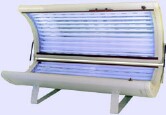- Understanding the Connection Between Anxiety and Depression
- How Daily Prunes Can Influence Cholesterol and Inflammation
- When to Take B12 for Better Absorption and Energy
- Epsom Salts: Health Benefits and Uses
- See What Saffron Can Do for Sleep and Heart Health
- 6 Common Mistakes to Avoid Before Your Physical
- Can Sweating Really Help You Beat a Cold?
- Strengthening Your Relationship: Practical Strategies
- Skip Storing This Everyday Product in the Fridge Door
- Green Tea + B3 Pairing May Boost Brain Health
Indoor Tanning Tied to Burns, Fainting, Eye Injuries: Study


Studies have shown that tanning beds are tied to a higher long-term risk for skin cancer, but new research finds that about 3,200 Americans wind up in ERs every year with serious burns or from passing out after an indoor tanning session.
People suffer first- and second-degree burns from tanning too long, said lead researcher Gery Guy Jr., from the division of cancer prevention and control at the U.S. Centers for Disease Control and Prevention.
Others develop eye injuries, including redness and burning, from exposure to ultraviolet (UV) radiation, he noted.
“In terms of passing out, people reported falling down after stepping out of a tanning bed,” Guy said. Although the reason isn’t clear, fainting could be caused by heat exhaustion, he said.
The good news is that these injuries decreased between 2003 and 2012. The bad news is rules governing indoor tanning are not followed well, Guy said.
“There were several cases where individuals reported falling asleep in the tanning bed, resulting in overexposure and burns,” Guy noted. “That’s interesting because there are regulations that indoor tanning beds have timers, so this may mean that timers weren’t working or people are overriding the timers so they can stay in longer.”
One expert said such practices are unacceptable.
“It is not acceptable to hold yourself as providing a safe treatment with a device that emits UV radiation when your machines’ safety timers are either disabled or bypassed,” said Dr. Jeffrey Salomon, an assistant clinical professor of plastic surgery at Yale University School of Medicine.
Salomon explained that the longer you’re exposed to ultraviolet radiation, the greater the risk of burns of the skin. Also, the higher the energy level from the device, the less time it
takes to burn the skin. In addition, people with fair complexions burn faster than people with dark complexions, he said.
“The providers of skin tanning must individualize treatment for each client based on skin type, power level and duration,” Salomon said. “If they can’t and won’t do that, then they should not be allowed to offer the service whatsoever.”
Four out of five tanning-salon injuries were skin burns, according to the study, published Dec. 15 online in JAMA Internal Medicine. Fainting and eye injuries accounted for fewer than 10 percent of reported injuries.
Injured tanners were mostly women and white (about 80 percent in each case), the study found. Young adults 18 to 24 years old represented more than one-third of the injured list.
Burns severe enough to require emergency treatment indicate overexposure to harmful UV radiation and increase skin cancer risk, the study authors said.
John Overstreet, executive director of the Indoor Tanning Association, an industry group, disagreed with the authors’ interpretation of the findings.
“I think the story is how few injuries actually occur and how much progress the industry has made in making a low number of injuries even lower,” he said. “Clearly during the 10 years covered by the study, the industry made significant progress in making sure customers do not suffer injury. That is a safety record all industries should strive to achieve.”
But the CDC recommends that people avoid indoor tanning altogether, Guy said.
For the study, Guy and his colleagues collected data on indoor-tanning-related injuries from 2003 to 2012 from 66 U.S. hospital emergency rooms. They identified 405 such injuries.
Based on this finding, Guy’s team estimated that an average of 3,234 indoor-tanning-related injuries were treated annually across the country.
They also found that the number treated each year dropped from about 6,500 in 2003 to just under 2,000 in 2012, probably because fewer people are using tanning salons, Guy said.
More information
For more on indoor tanning, visit the U.S. Centers for Disease Control and Prevention.
Source: HealthDay
Copyright © 2026 HealthDay. All rights reserved.










